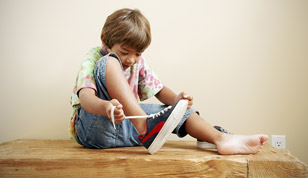Blog Categories
Search Blog
Blog Categories
The “Two Colour Lace Trick” For Shoelace Tying
Teaching children how to tie their shoes can be a challenging task – both for the child learning how and the parent trying to teach it. With all of the methods out there (i.e. bunny ears, wrap around, Ian knot), it’s hard to know which one will work best for your child. Further, there seems to be a plethora of books, toys, devices and equipment promising to make this complex skill easier to master. A question that I’m constantly asked is, “Are any of them really worthwhile?”
A number of factors contribute to the difficulties that children have with learning how to tie their shoes. Firstly, refined dexterity of the fingers is required. A child must be able to isolate his/her pincer (thumb and index) fingers to securely grasp onto the laces, while keeping the rest tucked behind so that they aren’t in the way. In addition, knowing the correct sequence of steps is essential to ensure accuracy. However, what most often confuses children is differentiating between the two ‘sides’ of the laces. This leaves them asking the following questions; “which side wraps around where?”, “which bunny ear goes through the hole?”, etc.
It is for these reasons that I say forgo the fancy devices and teach shoelace tying with these simple items: two different colored pipe cleaners and a hand towel. The pipe cleaners can be attached using a quick twist of both ends, and then wrapped around a rolled towel, as pictured below. Using pipe cleaners allows the child to master the steps involved (using whichever method you have chosen), while eliminating the ‘flimsiness’ that laces can have. The two colors make it easier to actually see what you are doing. It also assists the adult when providing verbal cues. Rather than saying, “move one bunny ear behind the other and then put it inside the hole”, they can be more specific and say, “move the red bunny ear behind the blue bunny ear and then put the red bunny ear inside the hole”. Once mastered with pipe cleaners, move onto using two coloured laces around the towel, before progressing to actual shoes. This eliminates the pressure and keeps it part of the ‘learning phase’.
Once the child feels comfortable, you can progress to tying actual shoes. However, the two colour lace trick should still be utilized. This is where you can get creative. The simplest way to make this is to colour white laces two different colours using fabric or permanent markers (pictured below). However, I’ve seen parents use puffy paint to add different coloured dots/patterns and I’ve also seen coloured thread sewn into laces to differentiate the two sides. Involve your child in this activity and make it a fun craft project.
Shoelace tying is one of my favourite things to work on as an occupational therapist. With the steps broken down and the task demands minimized, acquiring the skill is not necessarily all that challenging. It’s unbelievable how accomplished a child feels once mastered; this is particularly true given the independence and maturity that shoelace tying represents. Pictured below is a statement that a wonderful client wrote, acknowledging the accomplishment of her goal to tie her shoes. It now hangs in our waiting room at Boomerang Health!










